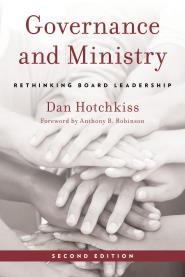
by Dan Hotchkiss
It is not always easy to say what kind of planning a congregation needs to do at a specific moment. Nonetheless, dogmas abound. Some people think every congregation has to do a big, ginormous long-range, planning process every five or ten years. Only by taking a fresh, comprehensive look at everything and translating all of it into a thick report can a congregation have a serious sense of direction.
An opposing camp says “strategic planning” is an old-hat, GI-generation dinosaur. In our time, it’s futile to predict the future. Progress comes only by infusing the whole system with an agile, nimble, trial-and-error culture. The anti-planning movement even has a mocking coffee mug: “We have a strategic plan—it’s called doing things.”
I sympathize with both extremes, so I can relate when puzzled lay and clergy leaders call and say, “We think it’s time to do a new strategic plan. But what kind of planning should we do?” Before gearing up for what could turn out to be a wasteful, ineffective type of planning effort, it’s smart to think about what kind of planning is appropriate.
Here are some questions that can guide decision making:
1. Should we do a long- or short-range planning process?
A few congregations mount five- or ten-year planning processes one after another and can point proudly at completed checklists of big changes to program, staffing, physical facilities, and funding. These congregations tend to have long clergy tenures, low turnover of lay leaders, and stable community environments. But most importantly, they have a habit of asking, when a big decision comes along, “What does our strategic plan say? What decision will advance us toward our goals?” These congregations often own multiple, well-thumbed copies of Holy Conversations: Planning as a Spiritual Practice for Congregations, by Gil Rendle and Alice Mann, which is, in my opinion, the best guide available for a full planning process.
I admire these congregations and encourage others to consider following their example, but not every congregation can. One reason is that effective planning must involve those who will implement the plan. Congregations that expect a change of clergy leadership should focus on short-term plans that the current team of leaders can accomplish.
One short-term planning focus is the clergy transition itself: What input should we give to the search committee and denominational staff about the kind of clergy leadership we need? This kind of planning has profound implications for the long-term future, but is focused on decisions of the current leadership.
Most congregations have a long list of short-term decisions needing to be made. What big steps forward will we take this year? Is it time to reach out to immigrant families in our neighborhood, fix the front porch, or organize a youth choir? Experiments like these can lead to longer-term accomplishments, but start with one step current leaders can complete this year.
Short-term planning is a good choice in congregations that find it difficult to make and implement decisions. This can happen after a major conflict, or in a congregation with a history of spinning grand (or even not-so-grand) plans that don’t get implemented. It can be worthwhile to pick one or two relatively uncontroversial practical goals and walk through the formal steps of board decision-making, delegation, resourcing, and evaluation. The goal is to build competence, confidence, and trust, perhaps as a prelude to a long-term planning effort.
2. Should our planning focus be technical or adaptive?
Thanks to Ronald Heifetz’s Leadership Without Easy Answers, many leaders know these terms:
- Technical challenges can be met using knowledge, skills, and information leaders already have or can straightforwardly acquire. Examples: filling an established staff position, refreshing a worn youth room, building extra classrooms to relieve crowding.
- Adaptive challenges call for deeper learning, because no solution (or list of alternative solutions) has yet been discovered. Examples: drawing Millennials into leadership, reaching out to a changed neighborhood, addressing deep differences about core faith issues.
As often happens when new terms become familiar, misconceptions abound. For instance, many people think that a big challenge automatically is an adaptive challenge. Not so: in many congregations, the inevitable outcome of a planning process is to add more building space. Construction might be an adaptive response—but often it is simply a knee-jerk remedy slapped onto an unexplored new situation. Adaptive work is not the same as undertaking a big project.
Another common mistake is to assume that adaptive work is always superior to technical work, when what matters is to make a wise choice in the circumstance. For instance, after a major decision, the top priority for several years is to work out the practical implications rather than to raise “adaptive” doubts about whether the decision was correct.
Many lay leaders with experience in planning have worked only on technical planning. Especially in large organizations, most managers and professionals engage in planning only after strategic direction has been set by senior management. The concepts of technical and adaptive challenges can be especially helpful as such leaders stretch their understanding to fit their new role as “senior managers” in the congregation.
3. Should we plan for the whole congregation or just part of it?
Even a small congregation has several distinct programmatic parts: worship, music, and education for example. Integrating these potential “silos” and getting them to think about the whole is one of the many benefits of comprehensive, whole-congregation planning.
But integration is not everything. Each program unit needs to plan, and at least some of that planning is best done separately. An exclusive focus on whole-system planning can actually undermine the program units by suggesting that responsibility for planning rests only with top board and clergy leaders.
One large church integrates top-level with program-unit planning by giving each year a name. In that church, each year is the Year of Youth, the Year of Music, or the Year of Social Witness. This practice draws the attention of the entire system toward a planning process that belongs primarily to the program unit currently in the spotlight. Unit leaders have an opportunity to educate the congregation about their special area, while also demonstrating how they support the broader mission of institution.
For every thing there is a season, and at every time, each congregation has a planning task to do. Choosing the right planning focus is an important first step toward success in planning. Unfortunately, many clergy, congregations, and consultants have experienced success in only one or two types of planning. Equipped with a hammer that has been successful for them in the past, they see nails every time! By thoughtfully considering the situation, leaders can choose the right planning process at each moment and ensure that planning work produces positive results.
[box] Dan Hotchkiss consults with congregations and other mission-driven groups from his home near Boston. He is the author of the best-selling Alban book Governance and Ministry: Rethinking Board Leadership, which has helped hundreds of churches, synagogues, and non-profit organizations to streamline their structure and become more mission-focused and effective.
Dan Hotchkiss consults with congregations and other mission-driven groups from his home near Boston. He is the author of the best-selling Alban book Governance and Ministry: Rethinking Board Leadership, which has helped hundreds of churches, synagogues, and non-profit organizations to streamline their structure and become more mission-focused and effective.
[/box]
